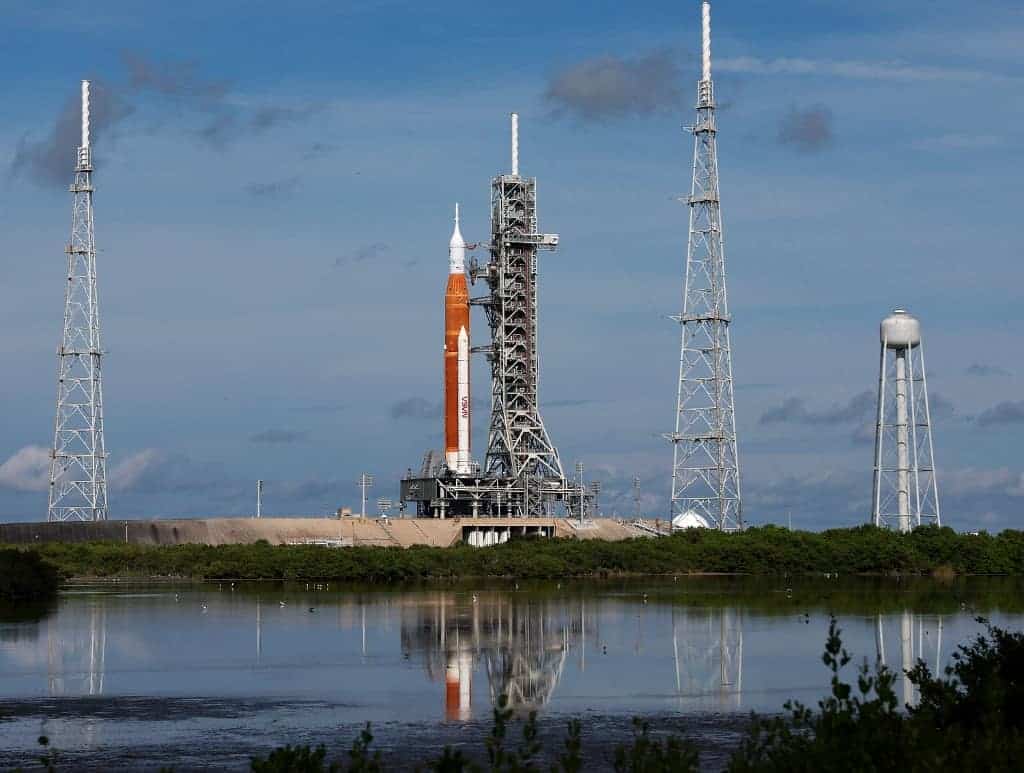Fifty years after the last Apollo mission, the Artemis program is poised to take over lunar exploration with a test launch Monday of the most powerful rocket in NASA history.
The goal is to return humans to the Moon after the 1972 Apollo mission, and eventually to Mars. The 98-meter Space Launch System (SLS) rocket is scheduled for liftoff at 8H33 (12H33 GMT) from the Kennedy Space Center (KSC) in Florida.
The mission, planned for more than a decade, is unmanned but highly symbolic for NASA, given the pressure from China and private competitors such as SpaceX.
Hotels around Cape Canaveral are fully booked and between 100,000 and 200,000 spectators are expected to attend the launch.
The huge orange-and-white rocket has been stationed at KSC’s Launch Complex 39B for the past week. “Since it was sent to the pad last week, you can feel the excitement, the energy,” says Janet Petro, KSC director. “It’s really palpable.”
The goal of the flight, christened Artemis 1, is to test the SLS system and the Orion crew capsule located at the tip of the rocket.nMannequins equipped with sensors will take the crew members’ places and record acceleration, vibration and radiation levels.
In addition, cameras will capture every moment of the 42-day journey and a “selfie” will be taken of the spacecraft with the Moon and Earth in the background.
Landing in the Pacific
The Orion capsule will orbit the Moon and approach to within 100 km and then fire its engines to reach a distance 64,000 km farther, a record for an aircraft suitable for carrying humans.
One of the main objectives of the mission is to test the capsule’s heat shield, which at nearly 5 meters in diameter is the largest ever built.
On its return to Earth’s atmosphere, the heat shield must withstand a speed of more than 40,000 kilometers per hour and a temperature of 2,760 degrees Celsius.
Orion, whose descent will be slowed with parachutes, will end its journey with a splashdown off the coast of San Diego in the Pacific.
Liftoff Monday will depend on weather, which can be unpredictable in Florida this time of year, so NASA contemplated a two-hour launch window.
If the rocket cannot lift off on Monday, alternative dates are planned for Sept. 2 or Sept. 5.
Everything is ready. NASA gave the mission the green light Tuesday after a detailed inspection. That doesn’t mean things can’t go wrong as this is the first flight of the capsule and rocket.
Inherent risk
“We’re doing something that is incredibly difficult to do and it carries inherent risk,” said Mike Sarafin, Artemis 1 mission manager.
Because it is an unmanned flight, Sarafin says the mission will continue in conditions that would not be suitable for a trip with astronauts.
“If we failed to deploy solar panels we would continue, and that’s something we wouldn’t necessarily do on a manned mission,” he explained.
An overall mission failure would be devastating to the program, which costs $4.1 billion per launch and is already behind schedule.
The next mission, Artemis 2, will carry astronauts to orbit around the Moon without stepping on its surface. The Artemis 3 crew is expected to land on the Moon no later than 2025.
While the Apollo astronauts who walked on the Moon were only men, the Artemis program plans to include the first woman and the first black person.
And considering that humans have already visited the Moon, Artemis has its sights set on another goal: sending a crew to Mars. The Artemis program aims to establish a permanent human presence on the Moon with a space station known as Gateway and a base on the lunar surface.
Gateway would serve as a preparation and refueling station for the journey to Mars, which at a minimum would take months.
“I think it will be inspiring even more than Apollo,” former astronaut and NASA associate administrator Bob Cabana opines about the Artemis mission.
“It will be absolutely awesome.”






